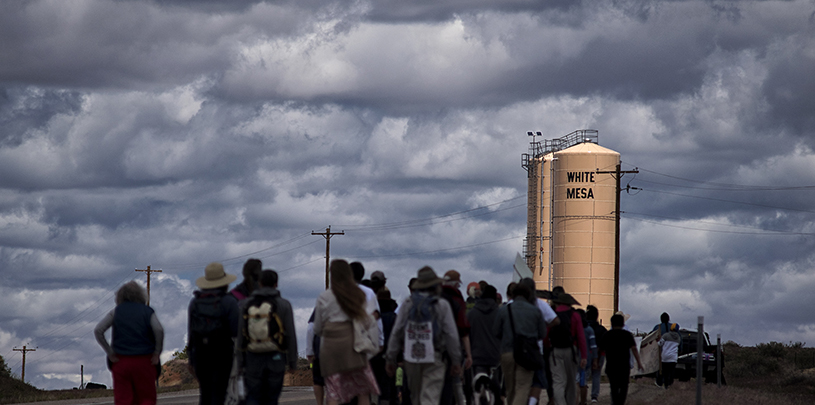
 by Tim Peterson, Cultural Landscapes Director
by Tim Peterson, Cultural Landscapes Director
UPDATE: The public comment deadline has been extended from June 5 to July 10, 2020. Comment now ›
Radioactive waste from the Baltic nation of Estonia could soon be shipped across the Atlantic and trucked to a uranium mill on the doorstep of Bears Ears National Monument if the state of Utah approves an application submitted by the mill’s owner, Energy Fuels Resources. Apparently, there is no facility in Estonia that can accept the waste — 660 tons of it in the first year — leftovers from a metals processing plant in the small European nation.
The Estonian waste, which contains less than half of 1 percent uranium ore, would be processed at the White Mesa uranium mill, just east of Bears Ears National Monument in southeastern Utah. The toxic sludge left over would then be dumped into the mill’s massive waste pits and remain onsite in perpetuity. The mill is just a few miles north of the Ute Mountain Ute Tribe’s White Mesa reservation. White Mesa community members worry that waste from the pits could contaminate the tribe’s drinking water.
“The mill has already become the cheapest alternative for disposal of low-level radioactive waste in North America,” Scott Clow, environmental programs director for the Ute Mountain Ute Tribe, told the Cortez Journal. “Now, it appears that it may become a destination for the materials from around the globe. That is disconcerting and dangerous,” Clow said.
The public has until July 10, 2020 to comment on the proposal to ship the waste to White Mesa for processing.
The White Mesa Mill was built to process uranium ore mined across the Colorado Plateau, including at mines near the Grand Canyon and around the Bears Ears region. But with uranium prices low, in addition to seeking a taxpayer-funded bailout, mill owner Energy Fuels Resources is pursuing additional contracts to process what it calls “alternate feed” — radioactive wastes from other industrial operations, like the facility in Estonia, or from contaminated military or industrial sites.

The current push to accept the waste from Estonia is part of a broader attempt to amend the mill’s operating license that includes a proposal to accept waste resulting from a massive railroad and water-delivery tunnel in Colorado. The proposed changes would also double a current cap on the amount of waste the mill is allowed to dump into its waste pits from uranium mines where chemicals are injected into the ground to dissolve uranium ore in place, and lift the cap entirely for waste from such mines owned by Energy Fuels Resources.
In addition to owning and operating the White Mesa Mill, Energy Fuels Resources owns an interest in hundreds of mining claims near Bears Ears National Monument. In 2017, represented by former lobbyist Andrew Wheeler, who is now the administrator of the EPA, the company successfully lobbied to shrink the borders of Bears Ears National Monument. Now Energy Fuels Resources wants to import radioactive waste from Europe, extract the tiny percentage of uranium it contains, and dump the remaining byproducts into a pit just outside the national monument’s boundaries, despite the longstanding and vocal concerns of Ute Mountain Ute tribal members just down the road.
Bears Ears is one of the richest cultural landscapes in the United States and an ancestral homeland of many tribes, including the Ute Mountain Ute, who have inhabited the region since time immemorial. It is a place for healing. Bears Ears deserves better than hundreds of tons of waste shipped to its doorstep from Estonia.
More than 275,000 pounds of radioactive materials imported from the Japan Atomic Energy Agency headed to Utah's White Mesa Mill.
Read MoreWhite Mesa Ute community leaders testify in Washington D.C. about how Utah's White Mesa uranium mill, near Bears Ears, affects their lives.
Read More"We want to have healthy lives. We want to have access to clean water," says Chairman Manuel Heart.
Read More